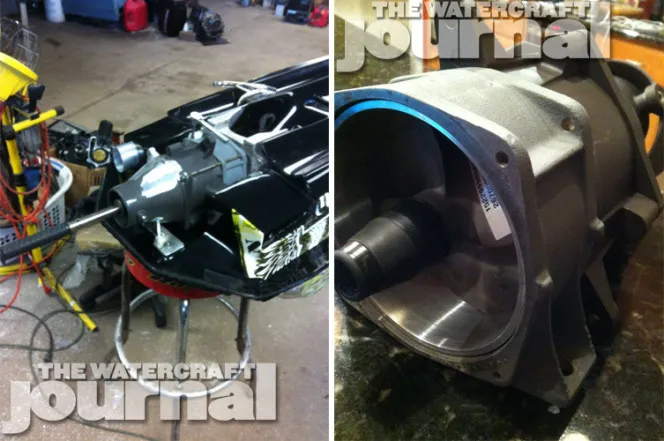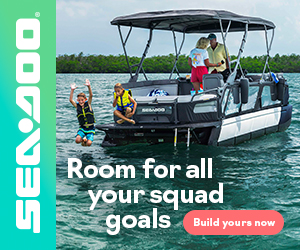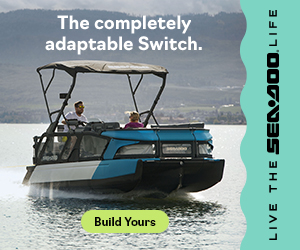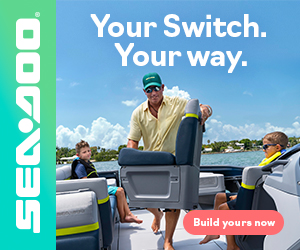Admittedly, there are few projects that truly catch our eye enough to really croon over them. A few months back we peeled the layers back on Keith Salles’ 110-mph SHO-powered Yamaha GPR because it was one of the most amazing conversion skis we’ve ever encountered. Maintaining the same level of scrutiny, we struggled to find a freeride ski that truly stood out among a crowd of already gorgeously-built freeride skis swimming in hand-formed carbon fiber, billet-ridden and sporting hugely torquey engines.
That was until we came across Chris Grace’s very peculiar Krash FootRocket. The Krash Industries’ ski is already a fine piece of equipment as it stands; weighing in at 88-pounds in the surf fiberglass version, and 77-pounds surf carbon version (and 66-pounds in the available flatwater carbon version). Krash designed the hull with dual purpose and maximum versatility by incorporating removable front sponsons, an adjustable rear tail plate and 6-inches of foothold adjustment.
Yet, this particular FootRocket had a far different destiny. Working with his other sponsors, TPE motors and Freeride Innovations billet parts, Chris and father Joe managed to get Krash involved with the build surprisingly easier than expected. “My son Chris is a freerider and team rider backed by Krash Industries,” Joe explained to The Watercraft Journal. “Chris was able to work with Nick Barton, owner of Krash Industries, to not only ride and promote his product, but to also become a Krash dealer on the East Coast. We have been importing and selling Krash hulls together for nearly a year now.”
A longtime rider and racer himself, Joe was no stranger to building his own custom standups “The first engine transplant I did was a Kawi 650 engine into a 550 hull in 1988,” Joe recalled. This eventually resulted in Joe owning his own dealerhsip – Wildwood Sea-Doo – for the past 16 years. So it was only natural when Joe first laid eyes on a Spark with the top deck removed to think that whole drivetrain looked narrow enough to fit into a stand up…potentially. “Since we’re Krash dealers,” Joe smiled, “we chose to try and make the motor fit into a Krash.”
The build required an impressive 300 man-hours between Joe and son to fit the Sea-Doo running gear into the ski. Consisting of “a 2015 Spark [900cc 4-stroke ACE] engine with a custom Yamaha wear ring that I pressed in an aluminum sleeve to fit the Spark’s prop, the rest of the running gear (pump, exit nozzle, internal electronics) is all [from a] 2015 Spark donor,” Joe explained.
 Impressively, the gas tank is a custom-fabricated aluminum tank that Joe mocked and welded himself. The exhaust too is custom. Finally, Joe had to lengthen the standard Spark drive shaft to make it work in the Krash hull. He continued, “The Krash hull comes with engine plates that were modified to accept the [factory] Spark motor mounts. I welded a custom chin pad that hold the [Sea-Doo] factory LCD gauges in it as well.”
Impressively, the gas tank is a custom-fabricated aluminum tank that Joe mocked and welded himself. The exhaust too is custom. Finally, Joe had to lengthen the standard Spark drive shaft to make it work in the Krash hull. He continued, “The Krash hull comes with engine plates that were modified to accept the [factory] Spark motor mounts. I welded a custom chin pad that hold the [Sea-Doo] factory LCD gauges in it as well.”
As for the instrumentation, Joe stated, “I didn’t have enough time to finish lengthening the wire harness at Daytona, so I rode with the digital gauge stored in the hull. The nice part about the Spark gauge is the speedometer sensor gets it’s data from a GPS receiver. No paddle wheel. Plus you get a tach and fuel level indicator. All the info from the Spark is retained.”
Getting the ski done in time proved to be its own challenge. “We wanted to have it fully completed and unveiled at the Daytona Freeride. However, we ran short on time and had to continue to work on it into the weekend at the freeride. [We] finally were able to water test it Saturday at the freeride. No unforeseen problems just simply ran short on time trying to complete the build.”
“The original test run was in the surf at Daytona Beach with the [factory] 60 horsepower setting. We jumped small waves and carved the surf, but the main emphasis was on monitoring the engine temperatures and exhaust to make sure they were in acceptable levels. The maiden voyage lasted 20 minutes in the surf with no issues,” Joe reported. “We found out later that the ski was filling with water. The trim cable tube was not sealed. The tube has a 5/8-inch inside diameter so water was coming in pretty fast.”
“We were super stoked that it ran so good with only 60HP,” he continued. “The Krash Industries FootRocket complimented the motor well as it carved exceptionally and the hull handled very well. The added low-end torque was pleasure for the surf and we are now working with VTech Tuned to get it tuned up to 110 horsepower, which we think will really set it off as a surf ski. We have not yet tested it in flat water, so we don’t know what the top speed is like yet.”
So what’s next for the Graces and their Rotax-powered “SparkRocket?” Wildwood will be reproducing the custom parts needed for the application and adding them to their line of Krash products (FootRocket, Predator, Reaper). “We believe this will be a truly international product. Our goal is to offer complete skis ready to ride in 90 days,” Joe beamed. Hopefully, crate versions of the Rotax ACE engine will be made available. Until then, for order inquiries contact either Joe at wwseadoo@yahoo.com or Chris at Gracechris@rocketmail.com.













